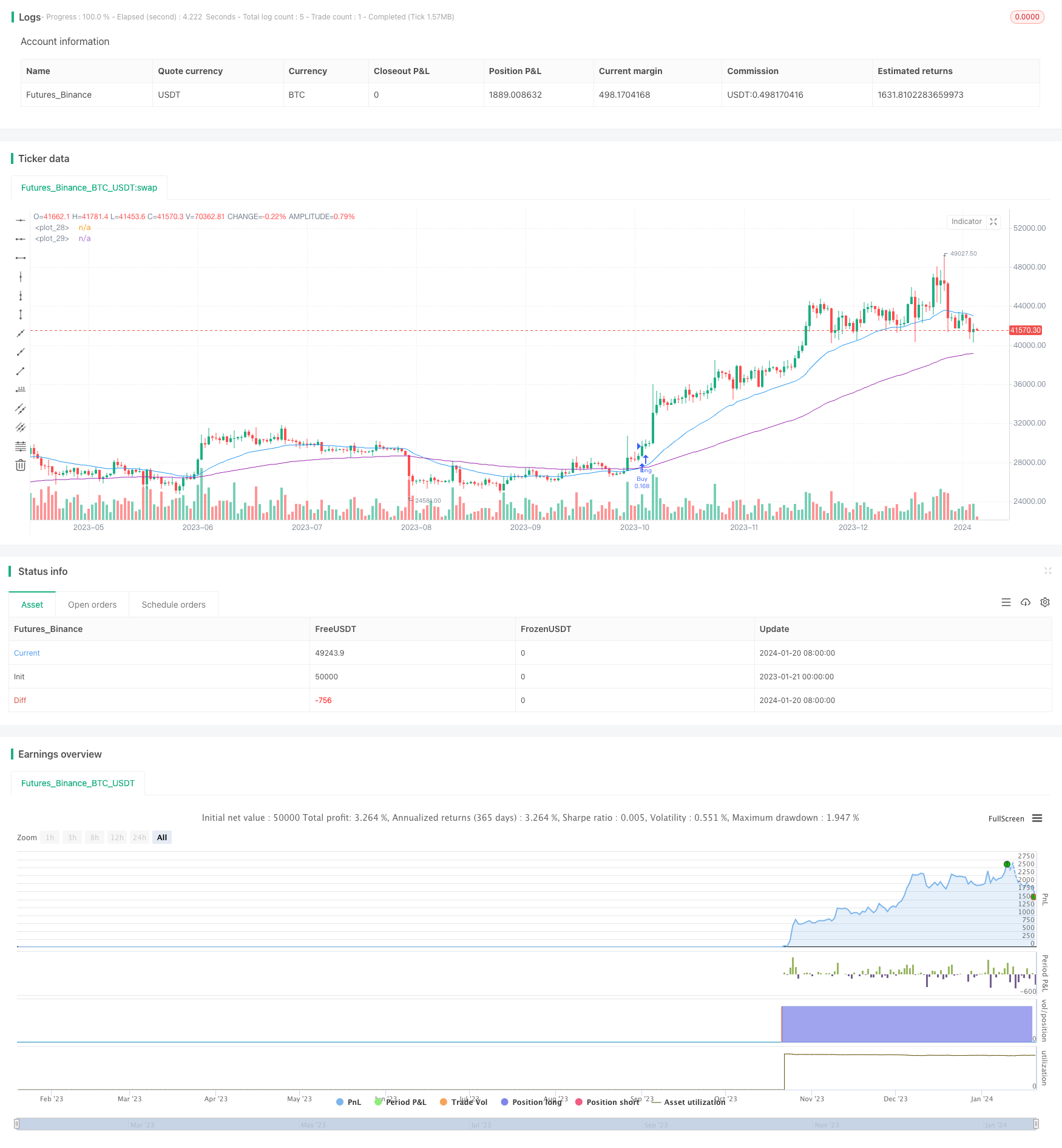
概述
本策略运用快速移动平均线和慢速移动平均线构建交易信号,实现对趋势的识别和跟踪。当快速线上穿慢速线时产生买入信号;当快速线下穿慢速线时产生卖出信号。该策略适合追踪中长线趋势,可以有效过滤市场噪音。
策略原理
本策略使用两条不同周期的Exponential Moving Average(指数移动平均线)作为交易决策的基础。快速移动平均线参数设置为30日,用来捕捉较短期的价格变动;慢速移动平均线参数设置为100日,用来判断价格中长线趋势的方向。
当快速线从下方上穿慢速线时,表示市场步入上升趋势,产生买入信号;当快速线从上方下穿慢速线时,表示市场步入下跌趋势,产生卖出信号。
策略优势
该策略具有以下优势:
- 基于均线构建,可以有效滤除短期市场噪音,顺势而为。
- 采用双均线策略,可以明确判断趋势方向。
- 实现参数优化,快慢均线周期可以自定义。
- 兼具追踪中长线趋势和短期调整的功能。
- 规则简单清晰,容易理解实现,适合初学者学习。
风险分析
该策略也存在一些风险:
- 当价格出现横盘整理时,容易产生错触发交易信号。可以通过优化均线参数来降低风险。
- 无法有效判断和处理价格剧烈波动的异常情况。可以设置止损来控制风险。
- 均线系统本身具有滞后性,可能错过价格转折点。可以结合其他指标进行优化。
优化方向
该策略可以从以下几个方面进行优化:
- 优化均线的周期参数,提高盈利效果。
- 增加其他条件判断指标,如交易量指标等,避免假突破。
- 增加止损策略,控制单笔损失。
- 结合趋势指标,判断趋势强度,避免趋势反转。
- 增加参数优化功能,使策略更具通用性。
总结
本策略基于双均线构建交易决策系统,通过快速均线和慢速均线的价格关系来判断市场趋势,信号生成简单清晰。该策略过滤了部分噪音,能够顺势而为,适合中长线趋势交易。但也存在一些缺陷,通过进行多指标优化和风险控制,可以将该策略优化得更加通用和高效。
策略源码
/*backtest
start: 2023-01-21 00:00:00
end: 2024-01-21 00:00:00
period: 1d
basePeriod: 1h
exchanges: [{"eid":"Futures_Binance","currency":"BTC_USDT"}]
*/
//@version=2
strategy("EMA Strategy v2", shorttitle = "EMA Strategy v2", overlay=true, pyramiding = 3,default_qty_type = strategy.percent_of_equity, default_qty_value = 10)
// === Inputs ===
// short ma
maFastSource = input(defval = close, title = "Fast MA Source")
maFastLength = input(defval = 30, title = "Fast MA Period", minval = 1)
// long ma
maSlowSource = input(defval = close, title = "Slow MA Source")
maSlowLength = input(defval = 100, title = "Slow MA Period", minval = 1)
// invert trade direction
tradeInvert = input(defval = false, title = "Invert Trade Direction?")
// risk management
useStop = input(defval = true, title = "Use Initial Stop Loss?")
slPoints = input(defval = 0, title = "Initial Stop Loss Points", minval = 1)
useTS = input(defval = true, title = "Use Trailing Stop?")
tslPoints = input(defval = 0, title = "Trail Points", minval = 1)
useTSO = input(defval = false, title = "Use Offset For Trailing Stop?")
tslOffset = input(defval = 0, title = "Trail Offset Points", minval = 1)
// === Vars and Series ===
fastMA = ema(maFastSource, maFastLength)
slowMA = ema(maSlowSource, maSlowLength)
plot(fastMA, color=blue)
plot(slowMA, color=purple)
goLong() => crossover(fastMA, slowMA)
killLong() => crossunder(fastMA, slowMA)
strategy.entry("Buy", strategy.long, when = goLong())
strategy.close("Buy", when = killLong())
// Shorting if using
goShort() => crossunder (fastMA, slowMA)
killShort() => crossover(fastMA, slowMA)
//strategy.entry("Sell", strategy.short, when = goShort())
//strategy.close("Sell", when = killShort())
if (useStop)
strategy.exit("XLS", from_entry ="Buy", stop = strategy.position_avg_price / 1.08 )
strategy.exit("XSS", from_entry ="Sell", stop = strategy.position_avg_price * 1.58)